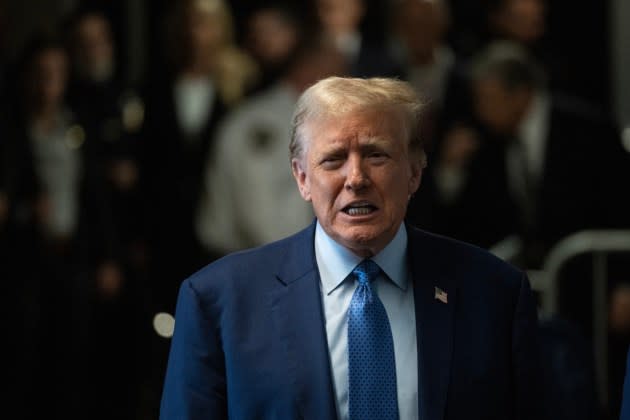Wargame Simulation Predicts NATO Collapse if Trump Is Elected Again
- Oops!Something went wrong.Please try again later.

If he becomes president again, a recently run wargame determined NATO could collapse under another Trump administration.
Donald Trump loves to complain about NATO and what he perceives as member nations not contributing enough financially to shared defense. He has threatened to put the U.S. on a “standby” position in NATO if member nations don’t bend to his will.
The wargame, run by British defense expert Finley Grimble, predicted that even if Trump doesn’t fully withdraw the U.S. from NATO, the organization could fall apart, Business Insider reported Sunday.
“A US policy of frustrating NATO has the potential to cause the alliance to collapse, with the EU as a candidate for eventually replacing NATO’s ultimate function — defending Europe from Russia,” Grimble, who served as wargamer and strategy advisor to the UK government, wrote on PAXsims.
According to the current National Defense Authorization Act, the president cannot “suspend, terminate, denounce, or withdraw” the U.S. from NATO without the “advice and consent” of a two-thirds majority of the Senate. But that doesn’t mean that a president couldn’t do serious damage to the treaty partnership without fully withdrawing.
“What Donald Trump can do is just really hollow out what NATO does,” Grimble told Business Insider. “He doesn’t need to leave NATO to ruin it. He can ruin it from within.”
U.K. experts in defense and intelligence participated in the wargame, playing the leaders of various countries. In the simulation, Trump took office and attempted to arrange a peace deal between Russia and Ukraine, with assistance from Turkey while excluding other European nations. When the deal failed to materialize, Trump severely restricted U.S. aid to Ukraine, and other nations moved to “fill the void.”
The simulation Trump’s next step was to go into “dormancy” in NATO (similar to Trump’s threat to go on “standby”) and withdraw half of the 100,000 U.S. troops currently deployed in Europe, sending them to the Indo-Pacific and decreasing U.S. involvement in NATO exercises. The simulated U.S. government then prohibited NATO’s Supreme Allied Commander in Europe (the SACEUR, who is always a U.S. official) from acting without first getting permission from the U.S.
“Ultimately, SACEUR is answerable to the president of the United States,” Grimble told Business Insider. “So [the SACEUR] can start slowing things down, or prevent things from happening. The U.S. can just take the funding from NATO programs and they will collapse.”
This policy of dormancy led simulation Turkey to consider withdrawing from NATO, and both Turkey and Hungary begin strengthening economic ties with Russia. In the simulation, Russia began exploring options to “cut off the Baltic States from the rest of NATO” but ultimately decided not to do so.
By Oct. 2026, the wargame predicted that Ukraine would sign a treaty with Russia recognizing Crimea and additional areas of Ukraine as Russian territories. Ukraine also installed a pro-Moscow government in Kyiv and agreed never to join NATO. Meanwhile, France decreased its participation in NATO, bringing tension between Poland, Germany and France.
During Nov. 2026 to Jan. 2027, the simulated Trump administration begins “in-depth senior talks to repair” bilateral U.S.-Russia relations, end the sanctions, and “resurrect the broken security architecture between them.” Plans are developed for a meeting between Russian President Vladimir Putin and Trump. During this time, the wargame predicted that U.S.-China tensions will escalate, U.S. relations with Europe will deteriorate, and NATO members will reduce their presence “given the perceived increase in likelihood for a Russian invasion.” All of this could lead to negative economic and security consequences for Europe.
More from Rolling Stone
Trump's GOP 'Surrogates' Take Turns Bashing Judge's Daughter
Cohen Says Trump Told Him Not to Worry About FBI Raid Because 'I'm the President'
The Hottest Place to Pledge Allegiance to Trump Is Manhattan Criminal Court
Best of Rolling Stone

